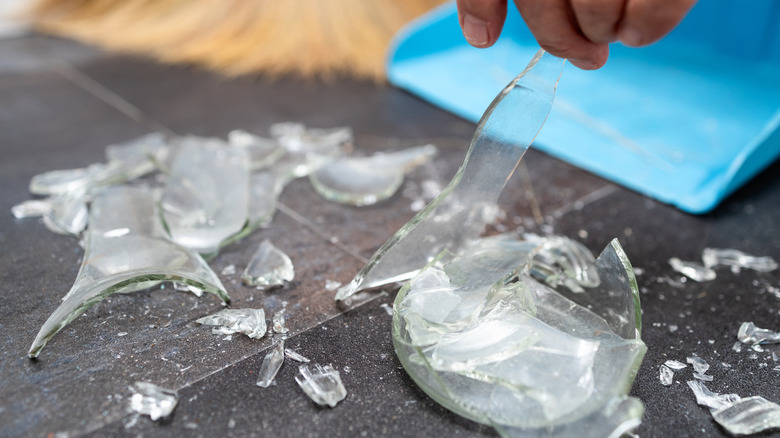Don't Throw Out Broken Glass & Use It To DIY Beautiful Wall Decor Instead
Did you know that broken glass often can't be recycled? Window glass, drinkware, and mirrors are particularly hard to recycle in most facilities, but even glass food and drink containers are sometimes trashed if they're in pieces. The next time you've got a broken jar in hand, hovering over the trash can, turn it into something that's literally dazzling. Crushed glass is a popular glittery addition to crafts, especially resin projects. This fun wall art project requires little to no prior artistic knowledge: Paint a canvas with an abstract design in a few colors, coat one section in resin, then encrust the resin with crushed glass for instant sparkle and a DIY way to incorporate resin art into your home
Make your own glass-resin artwork with either a blank stretched canvas or a repurposed piece from a thrift store. Buy some liquid acrylic paint in your choice of three colors along with a high-quality clear epoxy resin. You'll also need fine-grit sandpaper, resin polish, a good supply of crushed glass, and protective gear. Like handling glass shards, working with resin also has its hazards. Stay safe all around by wearing goggles and cut-resistant gloves as you work. If your resin brand recommends wearing a respirator while working with it, make sure that yours fits properly and is NIOSH-approved. If you're not using a respirator, have an N95 mask on hand. It's crucial to protect your lungs while sanding the crushed glass and the hardened resin during the final steps of the project.
Break it, don't buy it
You can buy pre-crushed and colored glass, but why purchase it when you can crush up your own for cheap or free? Your answer might be that it's potentially dangerous to deal with crushing your own glass. Well, it can be, but there are some smart precautions you can take to protect yourself. Before starting, gather up a tarp or a couple of repurposed pet food bags, a bucket, some old towels, a hammer, and a large, shallow cardboard box. If you'd like to dye your glass, grab some alcohol inks or mica powder in your desired colors along with one disposable cup and spoon per color you're mixing.
Set the box atop the open tarp, and line it with a towel. Let excess material fold over the box's sides for easy handling. Place glass containers in the box, cover them with another towel, and don protective wear. You may also want to wear a mask as extra precaution. Tap the towel-covered glass with the hammer until the pieces are small and relatively uniform. Lift the towel from the box, and tip its contents into the bucket. You can use the glass as-is or tint it.
With gloved hands and disposable cups, scoop a cupful of glass for each color you'll be using. Since it will be hard to replicate the exact color at another time, mix up a bit more of each color glass than you think you'll need. Add dye to the cup, and stir until the color is evenly distributed. Spread each batch onto a paper towel to dry for about 24 hours.
Complete your crushed glass masterpiece
Once the dyed glass is dry, get going on the painting process. An easy, low-skill design is to apply two colors of paint in two thick horizontal sections that divide the canvas in half. Brush the third color over the line where the first two colors touch. Use thick vertical strokes in irregular lengths to create a large jagged shape along the center axis of your canvas. Let the paint dry.
Place your canvas on your tarp to catch stray glass shards. Before mixing your resin, suit up in safety gear. Follow the instructions on the resin's container, and pour a thick coating over the design between the two painted sections. Use a clean paintbrush or foam brush to spread the resin over the design. Since resin hardens fast, work quickly to sprinkle the crushed glass over the wet resin. Cover each part of the resin's surface evenly with the crushed glass. Let the resin dry for the length of time recommended for your product. If you have a box that's larger than the canvas, invert it over the piece while it dries to keep dust and other unwanted stuff from sticking to the tacky resin.
Your textural wall art isn't quite ready for the wall yet; first, sand down the rough exposed glass edges to keep you safe if you accidentally touch or bump into your canvas. Put on the protective gear, including a mask to prevent inhaling fine glass or resin particles. Sand down the sharp exposed points of glass that protrude through the resin. Top the area with a resin polish according to the products' directions.

